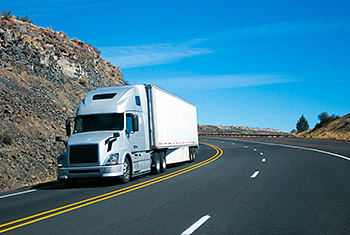What are the current and future medium- and heavy-duty vehicle fuel efficiency and greenhouse gas emissions standards?
According to the U.S. Environmental Protection Agency (EPA) and the National Highway Traffic Safety Administration (NHTSA), greenhouse gas (GHG) emissions from medium- and heavy-duty vehicles (collectively, HDVs) are expected to surpass light-duty vehicle (LDV) emissions by 2030. The Energy Independence and Security Act of 2007 directed the U.S. Department of Transportation to establish fuel efficiency standards for HDVs. Then, in 2010, President Obama announced a new national program to implement coordinated fuel efficiency and GHG emissions standards for medium- and heavy-duty engines and vehicles. As you may have seen last month, EPA and NHSTA finalized the most recent set of requirements under this program.
First promulgated by EPA and NHTSA in 2011, these coordinated standards are being implemented in two separate phases, beginning with Model Year (MY) 2014 to 2018 (Phase 1, which has now been extended through 2020) and followed by MYs 2021 to 2027 (Phase 2), with some exceptions. Under Phase 1, the GHG emissions and fuel efficiency standards generally increase in stringency in MY 2017, then remain steady through MY 2020. GHG emissions and fuel efficiency standards under Phase 2 of the program increase first in MY 2021, and then again in MYs 2024 and 2027. Although the Phase 2 standards do not begin until MY 2021, manufacturers may need to begin compliance measures beforehand in order to be adequately prepared to meet the targets.
Fuel efficiency and GHG emissions standards are determined differently for each of five regulated heavy-duty (HD) engine and vehicle categories: combination tractors; vocational vehicles; HD engines used in combination tractors and vocational vehicles; trailers used with combination tractors; and HD pickup trucks and vans. For more information on these categories, please refer to pages 3 and 4 of the EPA Phase 2 fact sheet.
NHTSA Fuel Efficiency Standards
NHTSA’s fuel efficiency standards are designed to take into account the different functions of each of the regulated vehicle categories. Therefore, the standards are calculated differently for each vehicle category. For HD pickup trucks and vans, there are separate gasoline and diesel target values.
The vehicle-based standards for combination tractors and vocational vehicles are calculated based on weight class, as well as specific characteristics of the vehicle category that affect fuel consumption and emissions, such as roof height for combination tractors and drive cycle for vocational vehicles.
The HD engine standards are determined by the size of the engine, the fuel type (diesel or gasoline), and the characteristics of the respective vehicles into which they are installed. The HD pickup and van standards, engine and chassis included, are fleet-average standards based on fuel-specific (gasoline and diesel) target values that are determined by a “work factor” curve. The “work factor” curve takes into account the payload and towing capacity of the vehicle and whether the vehicle has 4-wheel drive. Like the Corporate Average Fuel Economy (CAFE) program for LDVs, the HD pickup and van targets are production-weighted based on the manufacturer’s total sales volume of all of its different HD pickup and van models.
Compliance Timeline
Manufacturers were required to meet Phase 1 fuel efficiency standards for combination tractors, vocational vehicles, and HD engines beginning either in MY 2016 or 2017. Phase 2 standards apply in MY 2027, with phase-in standards for MYs 2021 and 2024. Trailer fuel efficiency standards are voluntary beginning in MY 2018, and mandatory effective MY 2021. Manufacturers were not required to participate in the Phase 1 HD pickup and van program until MY 2016. At the outset of the program, NHTSA gave manufacturers the option to choose one of the alternative phase-in options for the Phase 1 standards. Phase 2 HD pickup and van standards begin in MY 2021 and increase in stringency by 2.5% each model year through MY 2027.
Fuel Efficiency Standards and Targets
To view the final Phase 1 standards and HD pickup and van targets, please see the Phase 1 Final Rule. For the recently finalized Phase 2 standards and targets, see the Phase 2 Final Rule. You may also reach out to the Clean Cities Technical Response Service directly (technicalresponse@icfi.com) if you would like specific information about where to find the finalized standards.
EPA GHG Emissions Standards
EPA’s emissions standards calculation also takes into account the varying functions of each of the regulated vehicle categories. It uses the same factors as NHTSA to determine emissions standards for each vehicle category, except measurements are based on grams of carbon dioxide (CO2) emitted.
Compliance Timeline
EPA’s mandatory Phase 1 GHG emissions standards for combination tractors, vocational vehicles, and HD engines began in MY 2014. The timeline for the Phase 2 standards mirrors that of the NHTSA fuel efficiency standards. However, Phase 2 trailer emissions standards differ in that they are mandatory in MY 2018. For Phase 1 of the HD pickup truck and van program, similar to the fuel efficiency targets, manufacturers were given the option to choose from two alternative phase-in options. As with the Phase 2 fuel efficiency targets, the separate GHG emissions targets for diesel and gasoline HD pickups and vans will increase in stringency under Phase 2 by 2.5% per year from MY 2021 to 2027.
Emissions Standards and Targets
GHG emissions standards and targets for Phase 1 and Phase 2 can be found in their respective final rules. Please refer to the Fuel Efficiency Standards and Targets section above for more information.
Compliance
Manufacturers may employ many different compliance measures to meet the fuel efficiency and GHG emissions standards. These measures vary depending on the vehicle category. Each vehicle category has a different certification testing process to determine its GHG emissions and fuel efficiency values. These values are the baseline to which any additional earned credits can be added. The regulation also offers incentives to encourage advanced vehicle technologies.
The credits and incentives available for both the EPA and NHTSA programs include:
- Advanced Technology Credits: Phase 1 of the program incentivizes manufacturers to produce advance technology vehicles and engines by effectively allowing manufacturers to “count” certain vehicle and engine types as more than one in their compliance calculations. This includes vehicles with hybrid powertrains and Rankine-cycle waste heat recovery systems, as well as plug-in electric vehicles (PEVs) and fuel cell electric vehicles (FCEVs). As the new Phase 2 standards are premised on some use of Rankine-cycle engines and hybrid powertrains, these technologies will not qualify as advanced technologies under Phase 2. From MY 2021 through MY 2027, advanced technology credits (with considerably higher multipliers) will only be offered for PEVs and FCEVs.
- Innovative Technology and Off-Cycle Credits: Both Phases 1 and 2 of the program allow manufacturers to earn credits for off-cycle technologies that result in benefits that are not captured in certification testing procedures.
- Early Credit Multipliers: Phase 1 of the program enabled manufacturers to earn credits for early compliance. Phase 2 will not include early credits.
- Clean Cities Technical Response Service Team
- technicalresponse@icfi.com
- 800-254-6735
